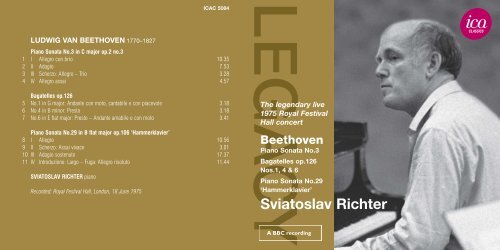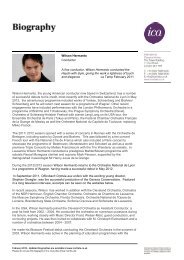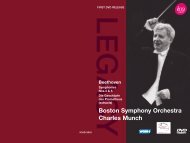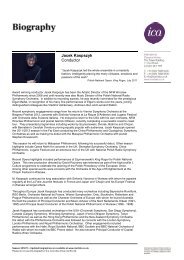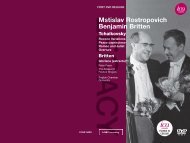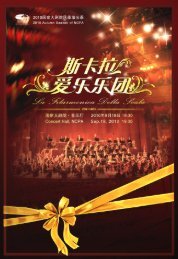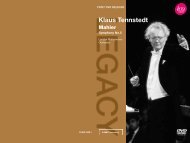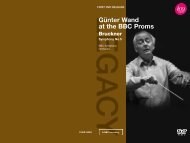to download - International Classical Artists
to download - International Classical Artists
to download - International Classical Artists
Create successful ePaper yourself
Turn your PDF publications into a flip-book with our unique Google optimized e-Paper software.
ICAC 5084<br />
LUDWIG VAN BEETHOVEN 1770–1827<br />
Piano Sonata No.3 in C major op.2 no.3<br />
1 I Allegro con brio 10.35<br />
2 II Adagio 7.53<br />
3 III Scherzo: Allegro – Trio 3.28<br />
4 IV Allegro assai 4.57<br />
Bagatelles op.126<br />
5 No.1 in G major: Andante con mo<strong>to</strong>, cantabile e con piacevole 3.18<br />
6 No.4 in B minor: Pres<strong>to</strong> 3.18<br />
7 No.6 in E flat major: Pres<strong>to</strong> – Andante amabile e con mo<strong>to</strong> 3.41<br />
Piano Sonata No.29 in B flat major op.106 ‘Hammerklavier’<br />
8 I Allegro 10.56<br />
9 II Scherzo: Assai vivace 3.01<br />
10 III Adagio sostenu<strong>to</strong> 17.37<br />
11 IV Introduzione: Largo – Fuga: Allegro risolu<strong>to</strong> 11.44<br />
SVIATOSLAV RICHTER piano<br />
Recorded: Royal Festival Hall, London, 18 June 1975<br />
The legendary live<br />
1975 Royal Festival<br />
Hall concert<br />
Beethoven<br />
Piano Sonata No.3<br />
Bagatelles op.126<br />
Nos.1, 4 & 6<br />
Piano Sonata No.29<br />
‘Hammerklavier’<br />
Svia<strong>to</strong>slav Richter
RICHTER PLAYS BEETHOVEN: THE 1975<br />
ROYAL FESTIVAL HALL RECITAL<br />
‘Pianist of the century’ is a phrase often used <strong>to</strong> describe<br />
Svia<strong>to</strong>slav Richter (1915-97) and not without reason.<br />
Bravura technique matched <strong>to</strong> high intelligence and a<br />
richly developed musical imagination is a rare combination<br />
of qualities in any instrumentalist.<br />
As a pianist, Richter was largely self-taught, albeit from<br />
within the confines of a deeply musical family. It was only<br />
after working as a répétiteur at the Odessa Opera that he<br />
travelled <strong>to</strong> Moscow <strong>to</strong> present himself <strong>to</strong> the great pianist<br />
and pedagogue Heinrich Neuhaus. Neuhaus recalled: ‘A<br />
young man arrived, tall, thin, fair-haired and blue-eyed. His<br />
face was alert and incredibly intense. He sat down at the<br />
piano, placed his long supple and powerful hands over the<br />
keys and began <strong>to</strong> play. His style of playing was reserved,<br />
simple, austere. The extraordinary musical perception that<br />
he showed won me over from the outset.’<br />
Life was not easy for Richter in Stalin’s Soviet Union. In<br />
1941 the Soviets shot his revered German-born musician<br />
father. Nor was there any quick escape. Richter was not<br />
heard in the West until 1960, five years after fellow<br />
Neuhaus pupil Emil Gilels who <strong>to</strong>ld an ecstatic American<br />
public: ‘Wait until you hear Richter!’.<br />
The piece with which the forty-five-year-old Richter<br />
introduced himself <strong>to</strong> the New York public was Beethoven’s<br />
Piano Sonata No.3 in C major, op.2 no.3. This was no<br />
inconsequential warm-up act but a powerful statement of<br />
intent, as indeed is the work itself. Completed in 1795 and<br />
dedicated <strong>to</strong> Beethoven’s teacher Haydn, the three op.2<br />
sonatas are the opening salvos in a sequence of thirty-two<br />
piano sonatas which over three decades would run<br />
alongside Beethoven’s nine symphonies and sixteen string<br />
quartets like a parallel mountain range.<br />
2<br />
The op.2 sonatas were deliberately laid out on a<br />
symphonic scale, in four richly developed movements<br />
rather than the more usual three. Argued with passion and<br />
precision, and with a fine epigrammatic wit, each sonata<br />
covers a vast range of thought and feeling. Technically they<br />
are far from easy. Beethoven was the leading keyboard<br />
virtuoso of the age in Vienna in the 1790s and was<br />
determined <strong>to</strong> exploit the fact in these sonatas.<br />
Richter recognised and relished every jot and tittle of<br />
the young Titan’s achievement here. In his diaries, he<br />
recalls hearing a recording by Artur Schnabel of another<br />
early Beethoven sonata, op.10 no.1. ‘I was literally<br />
as<strong>to</strong>unded by this remarkable interpretation. The sonata is<br />
suddenly brought <strong>to</strong> life <strong>to</strong> the point where it’s almost<br />
palpable. It was splendid.’ Much the same could be said of<br />
this 1975 London performance of op.2 no.3.<br />
Between 1802 and 1816 Beethoven wrote no piano<br />
sonatas in the full four-movement form. The return <strong>to</strong> the<br />
form came with the sonatas opp.101 and 106, which in a<br />
sudden access of patriotism he described as being written for<br />
the ‘Hammerklavier’, the old German word for the pianoforte<br />
as opposed <strong>to</strong> harpsichord. In the event, the sobriquet stuck<br />
<strong>to</strong> op.106, which is not so much the Mount Everest among<br />
piano sonatas as the Mount Etna, so full of fire and wrath it is.<br />
The sonata was completed in 1819 and dedicated <strong>to</strong><br />
the Archduke Rudolf. It was a difficult time for Beethoven<br />
as he approached his fiftieth year. Litigation over his<br />
adopted nephew Karl, deep financial problems, and the<br />
vanishing of all hope where his deafness was concerned<br />
evinced not despair but that mix of anger, exultation and<br />
deep prayerfulness which characterises all the mighty<br />
works of this period: the Missa solemnis, the Ninth<br />
Symphony and the ‘Hammerklavier’ itself. Glorious <strong>to</strong> hear,<br />
all are creations which test musical technique and human<br />
resolve <strong>to</strong> the edge of destruction.<br />
The mood of the opening of the ‘Hammerklavier’ is one<br />
of open defiance and in the finale there is an anger that<br />
barely abates. Yet at the heart of the sonata lies an<br />
eighteen-minute slow movement which is plainly religious<br />
in character. Richter once remarked of the slow movement<br />
of the early op.7 Piano Sonata: ‘Beethoven seems <strong>to</strong> be<br />
communing with our Lord and affirming His existence.’<br />
This is even more palpable in the ‘Hammerklavier’ as<br />
Beethoven sublimates and transforms in<strong>to</strong> visionary art the<br />
anguish of the two opening movements. Not that the<br />
sonata’s more ferocious movements are at all reckless<br />
artistically. As Richter’s performance vividly attests, the<br />
‘Hammerklavier’ is from first note <strong>to</strong> last a work of<br />
extraordinary lucidity and clear-sightedness.<br />
Richter played this carefully crafted programme, in<br />
which the C major sonata is the proud herald of greater<br />
things <strong>to</strong> come, a good deal during 1975. The<br />
‘Hammerklavier’ was the work public flocked <strong>to</strong> hear but<br />
the entire recital merits close attention, not least the three<br />
op.126 Bagatelles which Richter deployed as a teasing<br />
pre-interval glimpse of Beethoven’s late mood. These<br />
aphoristic miniatures, Beethoven’s last significant music<br />
for the piano, are less concerned with process – with the<br />
business of becoming – than with the distillation of an<br />
image and the consecration of a mood. There are vestiges<br />
here of Beethoven’s old Promethean self. But at the outset<br />
of the first Bagatelle, in the strangely persistent trio section<br />
of the fourth and at the heart of the sixth we experience<br />
intimations of a deep inner calm: glimpses of a Great Good<br />
Place beyond the stir of worldly events.<br />
Richard Osborne<br />
3<br />
RICHTER JOUE BEETHOVEN : RÉCITAL<br />
DU ROYAL FESTIVAL HALL DE 1975<br />
On évoque souvent, non sans raison, Svia<strong>to</strong>slav<br />
Richter (1915–1997) comme le “pianiste du siècle”.<br />
Il possédait un ensemble de qualités plutôt rare pour un<br />
instrumentiste : une technique virtuose, une intelligence<br />
supérieure, et une imagination musicale largement<br />
développée.<br />
Bien qu’il soit issu d’une famille profondément<br />
musicienne, Richter était un pianiste largement<br />
au<strong>to</strong>didacte. C’est seulement après avoir travaillé comme<br />
répétiteur à l’Opéra d’Odessa qu’il se rendit à Moscou pour<br />
se présenter au grand pianiste et pédagogue Heinrich<br />
Neuhaus, qui l’évoqua ainsi par la suite : “Un jeune<br />
homme est arrivé, grand, fin, avec des cheveux blonds et<br />
des yeux bleus. Son visage était vif et incroyablement<br />
concentré. Il s’assit au piano, plaça ses longues mains<br />
souples et puissantes sur le clavier et il commença à<br />
jouer. Son style de jeu était réservé, simple, austère.<br />
L’extraordinaire compréhension musicale qu’il manifestait<br />
me convainquit dès le début.”<br />
La vie n’était pas facile pour Richter dans l’Union<br />
Soviétique stalinienne. En 1941, les Soviets fusillèrent son<br />
père vénéré, un musicien d’origine allemande. Il n’y avait<br />
pas de fuite rapide possible. On n’entendit pas Richter à<br />
l’Ouest avant 1960, cinq ans après Emil Guilels, son<br />
compagnon d’étude chez Neuhaus, qui affirma un jour à un<br />
public américain en extase : “Attendez d’entendre Richter!”<br />
A l’âge de quarante-cinq ans, Richter se présenta au<br />
public new-yorkais avec la Sonate pour piano n o 3 en<br />
ut majeur op.2 n o 3 de Beethoven. Ce n’était pas un<br />
échauffement anecdotique mais une puissante déclaration<br />
d’intention, comme l’est en fait l’œuvre elle-même.<br />
Achevées en 1795 et dédiées à Haydn, le professeur de
Beethoven, les trois Sonates op.2 sont les premières<br />
salves d’une série de trente-deux sonates pour piano qui<br />
ont accompagné sur trois décennies les neuf symphonies<br />
et les seize quatuors à cordes de Beethoven comme une<br />
chaîne de montagnes parallèle.<br />
Les Sonates op.2 ont été délibérément conçues à une<br />
échelle symphonique, en quatre mouvements richement<br />
développés plutôt que dans forme en trois mouvements<br />
plus usuelle. Développée avec passion et précision, et<br />
avec un admirable esprit épigrammatique, chaque sonate<br />
recouvre une vaste étendue de pensées et de sentiments.<br />
Techniquement, elles sont loin d’être faciles. Beethoven<br />
était le principal virtuose du clavier à Vienne dans les<br />
années 1790, et il était déterminé à exploiter la virtuosité<br />
dans ces sonates.<br />
Ici, Richter souligne chaque iota et se délecte de la<br />
réalisation du jeune Titan. Dans son journal, il se rappelle<br />
avoir entendu l’enregistrement par Artur Schnabel de la<br />
Sonate op.10 n o 1, l’une des premières sonates de Beethoven.<br />
“J’étais littéralement abasourdi par cette interprétation<br />
remarquable. La sonate prenait soudainement vie au<br />
point qu’elle en était presque palpable. C’était splendide.”<br />
On pourrait pratiquement dire la même chose de cette<br />
interprétation londonienne de la Sonate op.2 n o 3 qui date<br />
de 1975.<br />
Entre 1802 et 1816 Beethoven n’écrivit plus aucune<br />
sonate pour piano en quatre mouvements. Le re<strong>to</strong>ur à cette<br />
forme ne vint qu’avec les Sonates opp. 101 et 106 qui, par<br />
un soudain accès de patriotisme de leur auteur, portent<br />
l’indication “pour le Hammerklavier”, l’ancien mot<br />
allemand désignant le pianoforte par opposition au<br />
clavecin. Finalement, l’indication resta collée à la<br />
Sonate op.106, qui n’est pas tant le Mont Everest<br />
des sonates pour piano que le Mont Etna, en raison de<br />
ses élans enflammés et de ses grondements de colère.<br />
La sonate fut terminée en 1819 et dédiée à l’archiduc<br />
Rodolphe. A l’approche de son cinquantième anniversaire,<br />
Beethoven vivait une période difficile. Le litige sur<br />
l’adoption de son neveu Karl, d’importants problèmes<br />
financiers et l’abandon de <strong>to</strong>ut espoir en ce qui concerne<br />
sa surdité se traduisirent non pas par un désespoir, mais<br />
par un mélange de colère, de jubilation et un esprit de<br />
prière profonde caractéristiques de <strong>to</strong>utes ses grandes<br />
œuvres de cette période : la Missa solemnis, la<br />
Neuvième Symphonie et la Sonate “Hammerklavier”<br />
elle-même. Merveilleuses à écouter, ce sont <strong>to</strong>utes<br />
des créations qui mettent à l’épreuve la technique<br />
musicale et la détermination humaine jusq’au seuil de<br />
la destruction.<br />
L’atmosphère du début de la Sonate “Hammerklavier”<br />
est un défi ouvert, et dans le finale il y a une fureur qui<br />
ne faiblit presque pas. Cependant, au centre de la sonate,<br />
il y a un mouvement lent de dix-huit minutes au caractère<br />
clairement religieux. Evoquant le mouvement lent de la<br />
Sonate pour piano op.7, Richter fit remarquer un jour que<br />
“Beethoven semble communier avec le Seigneur et<br />
affirmer son existence.” Cela est encore plus palpable dans<br />
la Sonate “Hammerklavier” car Beethoven sublime et<br />
transforme en art visionnaire l’anxiété des deux premiers<br />
mouvements. Ce qui n’empêche pas les mouvements<br />
les plus agités d’être audacieux sur le plan artistique.<br />
Comme l’atteste l’interprétation éclatante de Richter, la<br />
Sonate “Hammerklavier” est, de la première à la dernière<br />
note, une œuvre d’une lucidité et d’une clairvoyance<br />
extraordinaires.<br />
Au cours de l’année 1975, Richter a joué un grand<br />
nombre de fois ce programme soigneusement agencé,<br />
dans lequel la Sonate en ut majeur annonce fièrement de<br />
plus grandes choses à venir. La Sonate “Hammerklavier”<br />
était l’œuvre que le public s’empressait d’aller écouter,<br />
mais le récital entier mérite <strong>to</strong>ute notre attention, et<br />
notamment les trois Bagatelles de l’opus 126 que Richter<br />
a déployées comme un aperçu annonciateur du climat du<br />
dernier Beethoven. Ces miniatures aphoristiques, dernières<br />
pièces importantes pour piano de Beethoven, sont moins<br />
affectées par les aspects de construction formelle que par<br />
la distillation d’une image et la recherche d’une<br />
atmosphère. On trouve ici des vestiges du vieux Prométhée<br />
beethovénien lui-même. Mais, au début de la première<br />
Bagatelle, dans l’étrange trio répété de la quatrième et au<br />
centre de la sixième, on ressent un calme intérieur<br />
profond, aperçu d’un havre idéal au-delà de l’agitation des<br />
événements terrestres.<br />
Richard Osborne<br />
Traduction : Jean-Jacques Velly<br />
4 5<br />
RICHTER SPIELT BEETHOVEN: DAS ROYAL<br />
FESTIVAL HALL RECITAL 1975<br />
“Pianist des Jahrhunderts” ist eine Phrase, die oft und<br />
nicht unbegründet benutzt wird, um Swja<strong>to</strong>slaw Richter<br />
(1915–1997) zu beschreiben. Bravouröse Technik<br />
gekoppelt mit gleichermaßen hoher Intelligenz und reich<br />
entwickelter musikalischer Einfallskraft ist eine seltene<br />
Kombination von Qualitäten in einem Instrumentalisten.<br />
Als Pianist war Richter vorwiegend Au<strong>to</strong>didakt, wenn<br />
auch innerhalb einer äußerst musikalischen Familie. Erst<br />
nachdem er als Korrepeti<strong>to</strong>r an der Oper Odessa gearbeitet<br />
hatte, ging er nach Moskau, um sich dem großen Pianisten<br />
und Pädagogen Heinrich Neuhaus vorzustellen. Neuhaus<br />
erinnert sich: “Ein junger Mann erschien, groß, schlank,<br />
blond und blauäugig. Sein Gesicht war aufgeschlossen und<br />
unglaublich intensiv. Er setzte sich ans Klavier, setzte seine<br />
langen, geschmeidigen und unglaublich starken Hände auf<br />
die Tasten und begann zu spielen. Sein Stil war reserviert,<br />
schlicht und streng. Die außerordentliche musikalische<br />
Einsicht, die er aufwies, überzeugte mich sogleich.”<br />
Das Leben in Stalins Sowjetunion war nicht leicht für<br />
Richter. 1941 erschossen die Sowjets seinen verehrten<br />
deutschen Musikervater. Es gab auch keine schnelle<br />
Ausflucht. Richter war erst 1960 zum ersten Mal im<br />
Westen zu hören, fünf Jahre nach Emil Gilels, sein<br />
Studienkollege bei Neuhaus, der zu seinem ekstatischen<br />
amerikanischen Publikum sagte: “Warten Sie, bis Sie<br />
Richter hören!”<br />
Das Stück, mit dem sich der 45-jährige Richter der<br />
New Yorker Öffentlichkeit vorstellte, war Beethovens<br />
Klaviersonate Nr. 3 C-dur, op. 2, Nr. 3. Dies war kein<br />
belangloser Aufwärmakt, sondern eine kraftvolle<br />
Absichtserklärung wie das Werk selbst. Die drei 1795<br />
vollendeten und Beethovens Lehrer Haydn gewidmeten
Sonaten op. 2 sind die Auftaktssalven für seine 32<br />
Sonaten, die er in den nächsten drei Jahrzehnten wie<br />
ein Nachbargebirge neben seinen neun Sinfonien und<br />
sechzehn Streichquartetten errichten sollte.<br />
Die Sonaten op. 2 wurden absichtlich nach<br />
sinfonischen Maßstäben in vier intensiv verarbeiteten<br />
Sätzen statt der üblicheren drei angelegt. Jede Sonate<br />
wird mit Leidenschaft und Präzision und feinem<br />
epigrammatischen Sinn durchgeführt und befasst sich mit<br />
einer weiten Bandbreite von Gedanken und Gefühlen.<br />
Technisch sind sie alles andere als leicht. Beethoven war<br />
in den 1790er Jahren in Wien der führende Klaviervirtuose<br />
seiner Zeit und entschlossen, sich diese Tatsache in<br />
diesen Sonaten zunutze zu machen.<br />
Richter erkannte und genoss hier jede Facette der<br />
Errungenschaften des jungen Titanen. In seinen<br />
Tagebüchern erinnert er sich an eine Aufnahme einer<br />
anderen frühen Beethoven-Sonate, op. 10, Nr. 1, von<br />
Artur Schnabel. “Ich war buchstäblich von dieser<br />
bemerkenswerten Aufnahme überwältigt. Die Sonate wird<br />
plötzlich so lebendig, dass sie fast greifbar wird. Es war<br />
herrlich.” Ähnliches könnte man über seine Aufführung<br />
von op. 2, Nr. 3 in London 1975 sagen.<br />
Zwischen 1802 und 1816 schrieb Beethoven keine<br />
Klaviersonaten in der vollen viersätzigen Form. Die<br />
Wiederkehr zu dieser Form folgte mit den Sonaten<br />
opp. 101 und 106, die er plötzlich patriotisch als “für das<br />
Hammerklavier” beschrieb – das alte deutsche Wort<br />
für das Pianoforte im Gegensatz zum Cembalo. Dieser<br />
Beiname haftete schließlich op. 106 an, die mit ihrem<br />
Feuer und Zorn in den Gefilden der Sonate eher den Ätna<br />
als den Everest repräsentiert.<br />
Die Sonate wurde 1819 vollendet und Erzherzog Rudolf<br />
gewidmet. Es war eine schwere Zeit für Beethoven, als er<br />
sich seinem 50. Lebensjahr näherte. Ein Gerichtsverfahren<br />
über seinen Adoptivneffen Karl, schwere Finanznöte und<br />
die hoffnungslose Situation seiner Ertaubung brachten aber<br />
nicht Verzweiflung sondern die charakteristische Mischung<br />
von Zorn, Jubel und tiefer Andächtigkeit mit sich, die alle<br />
gewaltigen Werke dieser Periode auszeichnet: die Missa<br />
solemnis, die Neunte Sinfonie und die “Hammerklavier”-<br />
Sonate selbst. Diese glorreich anzuhörenden Schöpfungen<br />
stellen musikalische Technik und menschliche<br />
Entschlossenheit bis zur Grenze der Zerstörung auf die<br />
Probe.<br />
Der Anfang der “Hammerklavier”-Sonate grüßt uns mit<br />
einer Stimmung unverhohlenen Trotzes, und das Finale<br />
drückt eine kaum nachlassende Wut aus. Im Herzen der<br />
Sonate liegt jedoch ein 18 Minuten langer, eindeutig<br />
religiöser langsamer Satz. Richter bemerkte einmal über<br />
die frühe Sonate op. 7, dass “Beethoven mit unserem<br />
Herrn zu kommunizieren und seine Existenz zu bestätigen<br />
scheint”. In der “Hammerklavier”-Sonate tritt dies noch<br />
deutlicher zutage. Beethoven sublimiert und transformiert<br />
die Qualen der ersten beiden Sätze in visionäre Kunst. Das<br />
heißt nicht, dass die wilderen Sätze künstlerisch einfach<br />
nur verwegen sind. Richters Ausführung attestiert lebhaft,<br />
dass die “Hammerklavier”-Sonate von der ersten bis zur<br />
letzten Note ein Werk von außerordentlicher Transparenz<br />
und Klarsicht ist.<br />
Richter spielte 1975 dieses sorgfältig gestaltete<br />
Programm häufig, in dem die C-dur-Sonate als s<strong>to</strong>lzer<br />
Vorbote größerer Dinge erscheint, die bevorstehen. Das<br />
Publikum kam in Scharen, um die “Hammerklavier”-Sonate<br />
zu hören, aber das gesamte Programm verdient unsere<br />
Aufmerksamkeit, nicht zuletzt die Bagatellen op. 126,<br />
die Richter vor der Pause als lockende Vorspeise auf<br />
Beethovens Spätstimmung spielte. Diese aphoristischen<br />
Miniaturen, Beethovens letzte signifikante Klaviermusik,<br />
beschäftigen sich weniger mit dem Prozess – dem<br />
6<br />
Werdegang – als der Destillation einer Anschauung und<br />
der Hingabe an eine Stimmung. Hier finden sich Spuren<br />
von Beethovens altem prometheischen Selbst. Aber am<br />
Beginn der ersten Bagatelle, dem seltsam beharrlichen<br />
Trio der vierten und im Herzen der sechsten erfahren<br />
wir Anklänge an eine tiefe innere Stille: flüchtige Blicke<br />
auf einen großen, guten Ort jenseits der Aufregungen<br />
weltlichen Geschehens.<br />
Richard Osborne<br />
Übersetzung: Renate Wendel<br />
For a free promotional CD sampler including<br />
highlights from the ICA Classics CD catalogue,<br />
please email info@icaclassics.com.<br />
7<br />
For ICA Classics<br />
Executive Producer/Head of Audio: John Pattrick<br />
Music Rights Executive: Aurélie Baujean<br />
Head of DVD: Louise Waller-Smith<br />
Executive Consultant: Stephen Wright<br />
Remastering: Paul Baily (Re.Sound)<br />
ICA Classics acknowledges the assistance of Milena Boromeo<br />
With special thanks <strong>to</strong> Keith Bennett<br />
Introduc<strong>to</strong>ry note & translations<br />
2012 <strong>International</strong> <strong>Classical</strong> <strong>Artists</strong> Ltd<br />
Booklet editing: WLP Ltd<br />
Art direction: Georgina Curtis for WLP Ltd<br />
2012 BBC, under licence <strong>to</strong> <strong>International</strong> <strong>Classical</strong> <strong>Artists</strong> Ltd<br />
Licensed courtesy of BBC Worldwide<br />
2012 <strong>International</strong> <strong>Classical</strong> <strong>Artists</strong> Ltd<br />
Technical Information<br />
Pyramix software<br />
Yamaha 03D mixing console<br />
CEDAR including Re<strong>to</strong>uch<br />
dCS conver<strong>to</strong>rs<br />
TC Electronic M5000 (digital audio mainframe)<br />
Studer A820 1/4" tape machine with Dolby A noise reduction<br />
ATC 100 active moni<strong>to</strong>rs<br />
Stereo ADD<br />
Sourced from the original master tapes<br />
WARNING:<br />
All rights reserved. Unauthorised copying, reproduction, hiring,<br />
lending, public performance and broadcasting prohibited.<br />
Licences for public performance or broadcasting may be obtained<br />
from Phonographic Performance Ltd., 1 Upper James Street,<br />
London W1F 9DE. In the United States of America unauthorised<br />
reproduction of this recording is prohibited by Federal law and<br />
subject <strong>to</strong> criminal prosecution.<br />
Made in Austria
Also available on CD and digital <strong>download</strong>:<br />
ICAC 5000<br />
Beethoven: Piano Concer<strong>to</strong>s Nos.1 & 3<br />
New Philharmonia Orchestra · Sir Adrian Boult<br />
Emil Gilels<br />
ICAC 5003<br />
Brahms: Piano Concer<strong>to</strong> No.2<br />
Chopin · Falla<br />
Kölner Rundfunk-Sinfonie-Orchester<br />
Chris<strong>to</strong>ph von Dohnányi · Arthur Rubinstein<br />
Gramophone Edi<strong>to</strong>rs’ Choice<br />
ICAC 5007<br />
Tchaikovsky: Symphony No.1 ‘Winter Dreams’<br />
Stravinsky: The Firebird Suite (1945 version)<br />
BBC Symphony Orchestra · Philharmonia Orchestra<br />
Evgeny Svetlanov<br />
ICAC 5008<br />
Liszt: Rhapsodie espagnole<br />
Hungarian Rhapsody No.2<br />
CPE Bach · Couperin · Scarlatti<br />
Georges Cziffra<br />
ICAC 5004<br />
Haydn: Piano Sonata No.62<br />
Weber: Piano Sonata No.3<br />
Schumann · Chopin · Debussy<br />
Svia<strong>to</strong>slav Richter<br />
Diapason d’or<br />
ICAC 5006<br />
Verdi: La traviata<br />
Maria Callas · Cesare Valletti · Mario Zanasi<br />
The Covent Garden Opera Chorus & Orchestra<br />
Nicola Rescigno · Supersonic Award (Pizzica<strong>to</strong> Magazine)<br />
ICAC 5020<br />
Rachmaninov: Rhapsody on a Theme of Paganini<br />
Prokofiev: Piano Sonata No.7<br />
Stravinsky: Three Scenes from Petrushka<br />
Kölner Rundfunk-Sinfonie-Orchester · Zdeněk Mácal<br />
Shura Cherkassky<br />
ICAC 5021<br />
Mahler: Symphony No.3 · Debussy: La Mer<br />
Kölner Rundfunkchor · Kölner Domchor<br />
Kölner Rundfunk-Sinfonie-Orchester · Dimitri Mitropoulos<br />
Toblacher Komponierhäuschen <strong>International</strong><br />
Record Prize 2011<br />
8<br />
9
ICAC 5032<br />
Beethoven: Piano Concer<strong>to</strong> No.4<br />
Tchaikovsky: Piano Concer<strong>to</strong> No.2<br />
Hallé Orchestra · Sir John Barbirolli<br />
London Philharmonic Orchestra · Kirill Kondrashin<br />
Emil Gilels<br />
ICAC 5033<br />
Mahler: Symphony No.3<br />
Waltraud Meier · E<strong>to</strong>n College Boys’ Choir<br />
London Philharmonic Choir & Orchestra<br />
Klaus Tennstedt<br />
Choc de Classica · Diapason d’or<br />
ICAC 5047<br />
Mendelssohn: A Midsummer Night’s Dream<br />
Beethoven: Symphony No.8<br />
Kölner Rundfunkchor · Kölner Rundfunk-Sinfonie-Orchester<br />
Ot<strong>to</strong> Klemperer<br />
ICAC 5048<br />
Brahms: Piano Concer<strong>to</strong> No.1<br />
Chopin · Liszt · Schumann · Albéniz<br />
BBC Symphony Orchestra · Rudolf Kempe<br />
Julius Katchen<br />
ICAC 5036<br />
Shostakovich: Symphony No.10<br />
Tchaikovsky · Rimsky-Korsakov<br />
USSR State Symphony Orchestra<br />
Evgeny Svetlanov<br />
ICAC 5045<br />
Chopin: Piano Concer<strong>to</strong> No.1<br />
Beethoven: Piano Concer<strong>to</strong> No.4<br />
Ot<strong>to</strong> Klemperer · Chris<strong>to</strong>ph von Dohnányi<br />
Kölner Rundfunk-Sinfonie-Orchester · Claudio Arrau<br />
Supersonic Award (Pizzica<strong>to</strong> Magazine)<br />
ICAC 5053<br />
Holst: The Planets<br />
Britten: Variations and Fugue on a Theme of Purcell<br />
BBC Symphony Orchestra<br />
Gennadi Rozhdestvensky<br />
ICAC 5054<br />
Beethoven: Missa solemnis<br />
Kölner Rundfunkchor<br />
Kölner Rundfunk-Sinfonie-Orchester<br />
William Steinberg<br />
10<br />
11
ICAC 5055<br />
Schubert: Impromptu in B flat<br />
Beethoven: Piano Sonatas Nos. 6 & 29<br />
Wilhelm Backhaus<br />
ICAC 5061<br />
Verdi: Falstaff<br />
Fernando Corena · Anna Maria Rovere · Fernanda Cadoni<br />
Glyndebourne Opera Chorus<br />
Royal Philharmonic Orchestra<br />
Carlo Maria Giulini<br />
ICAC 5068<br />
Verdi: Requiem · Rossini: Overtures<br />
Moscow Philharmonic Orchestra<br />
Orchestre National de l’ORTF<br />
Igor Markevitch<br />
ICAC 5069<br />
Rachmaninov: The Bells<br />
Prokofiev: Alexander Nevsky<br />
BBC Symphony Chorus and Orchestra<br />
Philharmonia Chorus and Orchestra<br />
Evgeny Svetlanov<br />
ICAC 5062<br />
Schumann: Piano Concer<strong>to</strong><br />
Beethoven: Eroica Variations · Piano Sonata No.30<br />
Kölner Rundfunk-Sinfonie-Orchester · Joseph Keilberth<br />
Annie Fischer<br />
ICAC 5063<br />
Brahms: Symphony No.3<br />
Elgar: Symphony No.1<br />
BBC Symphony Orchestra<br />
Sir Adrian Boult<br />
Supersonic Award (Pizzica<strong>to</strong> Magazine)<br />
ICAC 5075<br />
Berlioz: Requiem<br />
Nicolai Gedda<br />
Kölner Rundfunkchor<br />
Kölner Rundfunk-Sinfonie-Orchester<br />
Dimitri Mitropoulos<br />
ICAC 5076<br />
Wolf: Italienisches Liederbuch<br />
Janet Baker · John Shirley-Quirk<br />
Steuart Bedford<br />
12<br />
13
ICAC 5077<br />
Brahms: Piano Concer<strong>to</strong> No.2<br />
Debussy · Prokofiev<br />
Kölner Rundfunk-Sinfonie-Orchester<br />
Mario Rossi<br />
Emil Gilels<br />
ICAC 5078<br />
Rachmaninov: Symphony No.2<br />
Bernstein: Candide – Overture<br />
Philharmonia Orchestra<br />
London Symphony Orchestra<br />
Evgeny Svetlanov<br />
ICAC 5081<br />
Schumann: Symphony No.4<br />
Debussy: Le Martyre de Saint Sébastien – Suite<br />
Philharmonia Orchestra<br />
Guido Cantelli<br />
ICAC 5085<br />
Chopin: Piano Concer<strong>to</strong>s Nos. 1 & 2<br />
BBC Scottish Symphony Orchestra · Chris<strong>to</strong>pher Adey<br />
BBC Symphony Orchestra · Richard Hickox<br />
Shura Cherkassky<br />
ICAC 5079<br />
Grieg · Liszt: Piano Concer<strong>to</strong>s<br />
Lully · Scarlatti<br />
Orchestre National de l’ORTF<br />
Georges Tzipine · André Cluytens<br />
Georges Cziffra<br />
ICAC 5080<br />
Mahler: Das klagende Lied<br />
Janáček: The Fiddler’s Child<br />
Teresa Cahill · Janet Baker · Robert Tear · Gwynne Howell<br />
BBC Symphony Chorus and Orchestra<br />
Gennadi Rozhdestvensky<br />
ICAC 5086<br />
Beethoven: Piano Concer<strong>to</strong>s Nos. 2 & 4<br />
Sinfonia Varsovia<br />
Jacek Kaspszyk<br />
Ingrid Jacoby<br />
ICAC 5087<br />
Beethoven: Symphony No.3 ‘Eroica’<br />
Smetana: The Bartered Bride – Overture<br />
Orquesta Nacional de España · Orchestre de<br />
la Suisse Romande · Gran Orquesta Sinfónica<br />
Ataúlfo Argenta<br />
14<br />
15


